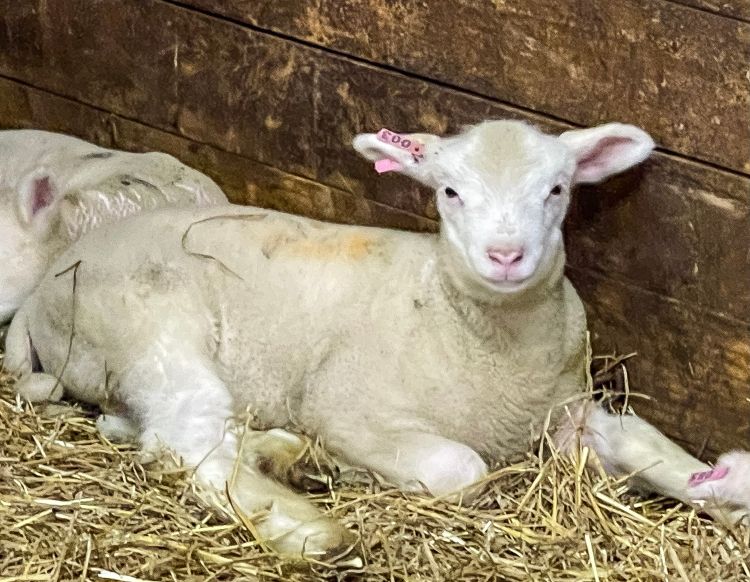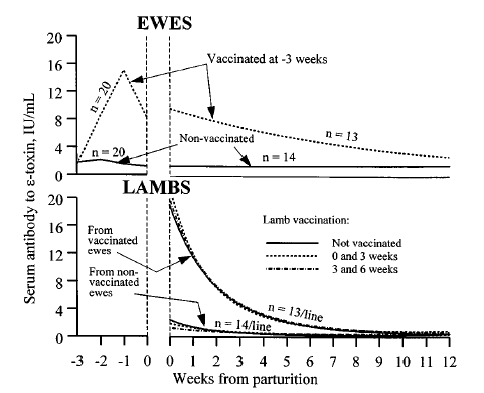Overeating disease in sheep: Making sense of vaccination schedules
Protecting against overeating disease requires timely vaccination and knowledge of risk. Lambs during the preweaning phase require passive immunity protection via vaccination of their dams during late pregnancy.

Overeating disease is also known as “pulpy kidney” disease or simply enterotoxemia. It is caused by an organism called Clostridium perfringens, and two major subtypes typically account for the vast majority of cases in sheep, types C and D. Type C principally produces a toxin called β-toxin (beta toxin), which is the actual agent of damage, and this form most commonly kills lambs less than two weeks of age. β-toxin produced by proliferation of type C organisms in the gut may also occur later in life, but in older animals, it is inactivated by proteases produced by the pancreas. A typical symptom of lambs that die from β-toxin is simply sudden death. This condition is commonly found either in large single lambs receiving lots of milk or in lambs born under difficult conditions that may be short on milk but then suddenly come into a situation of abundant milk supply (sudden weather changes in winter, movement between claiming pens, etc.). It is thought that the sudden influx of energy into the small intestine causes fast proliferation of the type C population and a corresponding massive release of β-toxin.
Type D principally produces a toxin called ε-toxin (epsilon toxin), which is the actual agent of damage and typically affects lambs older than 2 weeks of age as well as adult sheep. The majority of cases of enterotoxemia in older lambs, particularly those eating diets high in starch (high-grain diets, especially those high in corn and/or barley), is due to ε-toxin. When high levels of starch enter the small intestine following grain overconsumption, type D proliferates, quickly producing lethal levels of ε-toxin. Lambs exposed to high doses of ε-toxin also die very quickly, but occasionally are found in the final stages of life and commonly express symptoms of intense gut pain (kicking while lying of their side). Treatment is often unrewarding, but animals may respond to doses of Clostridium perfringens antitoxin given immediately upon appearance of early symptoms. Antitoxin is simply a preparation of antibodies against a given toxin and therefore has the potential to give immediate neutralization of the toxin. Consult with your veterinarian about these treatment options.
There is field evidence that sheep develop immunity to the ε-toxin if exposed to subclinical doses of Clostridium perfringens type D. Subclinical infection may occur “naturally” in animals fed grain diets, as the organism thrives in the lower gut under conditions that allow a large influx of starch into the intestine. This condition occurs when animals overload on grain, but may also occur in much more graded doses when animals consume grain diets. This graded exposure may allow immunity to develop and provide a natural level of protection to older lambs and grown sheep. It has been suggested that up to 30% of sheep in a flock may have sufficiently protective levels of antibody against ε-toxin in their system simply from subclinical infection. This may explain why only a handful of unvaccinated adult sheep may die from enterotoxemia when a flock of ewes gets loose and finds a pile of grain or are suddenly turned out into a lush pasture full of soluble carbohydrate. Deaths are also uncommon in lambs born to ewes vaccinated during late pregnancy (see Figure 1 and Protection Strategies) and fed a high-energy creep diet since early life. Lambs born to vaccinated moms receive passive protection from mom’s colostrum. If then consuming a high-energy grain diet, this can be further augmented by their own active protection via subclinical exposure to toxins.

Protection strategies
The two main protection strategies are vaccination and feeding management, with the most effective plan being a combination of the two. Feeding management is fairly straightforward: all adjustments to high starch (corn and/or barley-based) diets must be made SLOWLY. Michigan State University Extension also recommends replacing much of the starch component of a diet (corn and/or barley) with an energy supplement that has a slower and more sustained energy absorption profile from the rumen and lower gut. Such a supplement could be a highly digestible non-forage fiber feedstuff like soybean hulls. Substituting much of the starch component with soybean hulls when lambs are first placed on feed and then slowly replacing it with corn and/or soy is the safest and most effective means of adjusting lambs to a high-grain diet. This is particularly useful in older lambs weaned off a forage diet (such as lambs raised on pasture) and put onto a grain-based diet (when they enter the feed lot). Lambs exposed to high-starch feeds from an early age are at much less risk, as they may have had a chance to develop immunity to the subclinical level of toxin via grain consumption, producing regular exposure.
Vaccination is the other important protection strategy. There are several types of vaccines available to protect against both ε- and β-toxin, and many also confer protection against Clostridium tetani (organism that causes tetanus), which is an important added bonus. Tetanus is a terrible disease condition and can largely be eliminated with a vaccination program. Tetanus protection is particularly important in lambs docked outdoors in pasture birth programs, as they are more prone to infection from this largely soil-born organism.
The most efficient and effective way to protect lambs for the first 60 days of life is by immunizing their mothers as shown in Figure 1. This figure summarizes a study in which circulating antibody concentration against the ε-toxin was measured under several vaccination schedules. In this work, ewes were allocated to a vaccination group (Clostridium prefringens types C and D toxoid given 3 weeks prior to lambing) or to a control group receiving no vaccine. As you can see, the vaccinated ewes developed a rapid antibody response that declined over time and, more importantly, their lambs also received a huge dose of antibody at birth after consuming colostrum. In fact, antibody levels in the lambs following colostrum consumption were even higher than that of their moms. Antibody levels in lambs from vaccinated moms declined over time of course, but the authors surmised that lambs were adequately protected for up to 12 weeks of age. Farmers who have used this protocol (immunizing ewes 3 weeks prior to birth) have observed very few cases of enterotoxemia in lambs, and some have decided to forgo lamb immunizations altogether, especially if lambs are kept on a high plane of nutrition throughout the entire growth period. This practice saves labor and obstacles associated with the need to observe proper withdrawal periods for slaughter following immunization. This can be a lengthy period for a full immunization protocol (primary immunization followed by secondary immunization given 3 weeks later) as the withdrawal time for slaughter is 3 weeks, creating a lengthy 6-week total withdrawal period for slaughter for the full immunization protocol on lambs.
It is important to understand that all immunization strategies given to young lambs directly had NO effect on their circulating antibody levels. Lambs were vaccinated either at birth and 3 weeks or at 3 weeks and 6 weeks of age with the same vaccine (types C and D) given to ewes. It is clear from this study that vaccinating lambs before 6 weeks of age is completely ineffective. This is contrary to recommendations that have been prescribed for the past 30 years and bears important notice. As shown in Figure 1, the only effective treatment for lambs during early life is to immunize their dams during late pregnancy.
It is important to note that all vaccinated ewes had been given a previous vaccination against types C and D either during a previous pregnancy or as ewe lambs. It takes two immunizations (called primary and secondary) to get a protective level of antibody response. After primary and secondary immunizations, only a single booster immunization is needed to achieve effective protection. Another consideration when to vaccinate ewes is: what is the minimum period of time prior to lambing for giving the maternal immunization so the lambs still receive adequate protection? My recommendation is 7-10 days, as most booster immunizations will elicit a fast antibody response. Again, it is best to provide a full 3 weeks prior to lambing, but in most management situations we only have an educated guess about the due date of individual ewes. Based on this, I would recommend vaccinating 2 weeks prior to the first day of the lambing period if this period is less than 6 weeks. If greater than 6 weeks, it may be beneficial to boost the late-lambing ewes yet again.
Vaccine choices
There are several choices of vaccines to protect animals against clostridial organisms. The most cost-effective vaccine would be those that protect only against Costridium perfringens types C and D plus C. tetani (T), often called the “CDT” vaccine. There are other, more elaborate and expensive vaccines that protect against other clostridial organisms. These may have a place in treating high-value sheep, but they may not be cost-effective in many farming situations.
It is recommended to vaccinate previously immunized pregnant ewes with “CDT” 2 weeks before the first ewe in the group lambs. Additional protection may be needed for lambs (2 “CDT” immunizations, 3 weeks apart) after approximately 60 days of age, particularly if these lambs are not accustomed to a grain diet. Immunizing lambs themselves during early life is not an effective protection program.



 Print
Print Email
Email